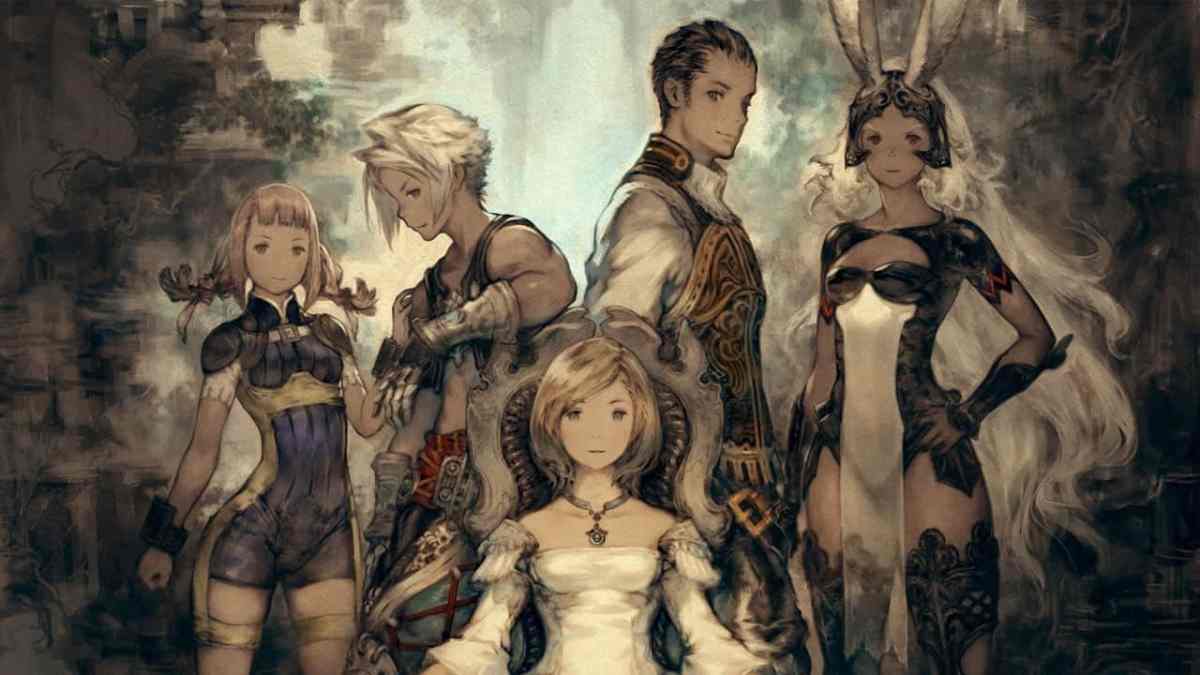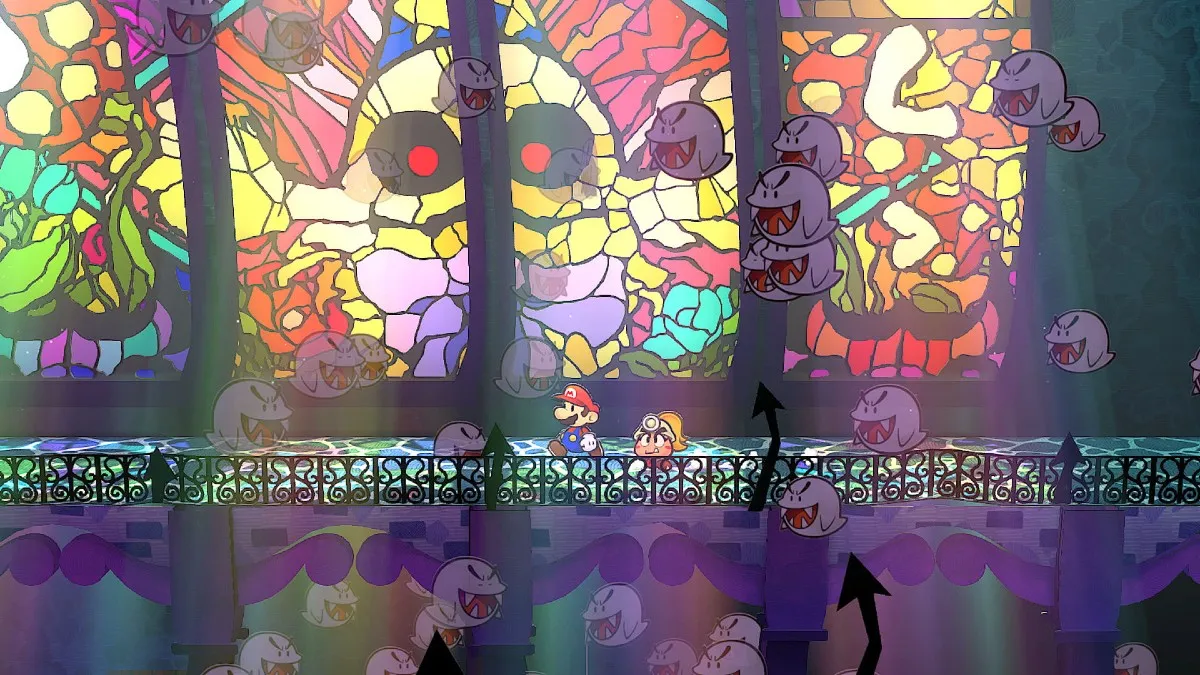The grind is real in the RPG genre. Save for a few rare exceptions like Final Fantasy VIII, if you’re playing some sort of RPG, chances are that you’re going to have to grind a few levels at some point. The same goes for Final Fantasy XII, which features a cool MMO-like, auto-battle style of combat.
The only difference is, Final Fantasy XII actually, dare I say, perfects the art of the RPG grind thanks to its innovative Gambit system.
Released for the Switch and Xbox One last week, Final Fantasy XII: The Zodiac Age is one of the last remaining single-player FF games I’ve yet to complete, and it’s been a wonderful journey so far. Since the launch of the Switch, Nintendo’s little hybrid system has fast become one of the best platforms for playing RPGs.
After all, there’s nothing better than grinding a few random battles in an area to level up your party while watching a movie on your couch. It’s busywork, and level grinding rarely ever requires your full attention, so what better way to grind than through the handheld Switch?
Level grinding on the Switch while watching something on Netflix is nothing new, but even with a handheld system, there are still times when you’d have to look at your screen, make a few easy decisions as a battle comes up, and hit a few buttons to progress.
Over the past few weeks, I’d been playing Final Fantasy X on Switch and I finally reached the Calm Lands, which was one of my favorite spots to put the story on pause for a bit and gain a few levels.
As great as FFX’s turn-based combat system is, though, the grinding process itself could still feel a little tedious as you’d have to manually switch out your party members to make sure everyone would get a bit of experience.
Not only that, FFX’s enemies are designed in such a way that you have to kill them with specific party members in order to clear the encounter as efficiently as possible, meaning more button presses for a single battle if you want to make sure every character gets a turn.
With Final Fantasy XII, the Gambit system removes almost all of that busywork, provided that you take the time to program your characters properly.
The cool, and somewhat divisive, thing about FFXII is that it has a combat system with the capability of playing itself. Our Editor-in-Chief Ed is a vehement naysayer when it comes to FFXII, often describing it as a boring single-player MMO-style game (Final Fantasy XI “Offline”) with a poor combat system, and the fact that Zodiac Age needs a fast-forward function to be fun speaks volumes about its gameplay.
I kind of agree to some extent, but I think it’s absolutely fascinating that this is a game that allows you so much freedom in customization, to the point where you can literally leave the game running and let your characters level up on their own with little to no input from the player.
It sounds like the magical grinding system; one where you only have to glance at the screen every few minutes to make sure everything’s running smoothly, then continue watching whatever you have on your other screen.
Reaching that RPG grinding nirvana takes work, though, and Final Fantasy XII insists that you fully understand its Gambit system before it allows you to go mad with automated party power.
This past weekend, I enjoyed the most magical Sunday evening ever, as I began my rewatch of Lost season 1 while letting my FFXII party farm some levels and license points in the Lhusu Mines.
To start, since my party was still relatively weak at that point, I needed someone in charge of healing duties to keep everyone alive. For that, I set up a full list of Gambits for Penelo, my White Mage, to ensure that she’d be able to keep everyone healthy.
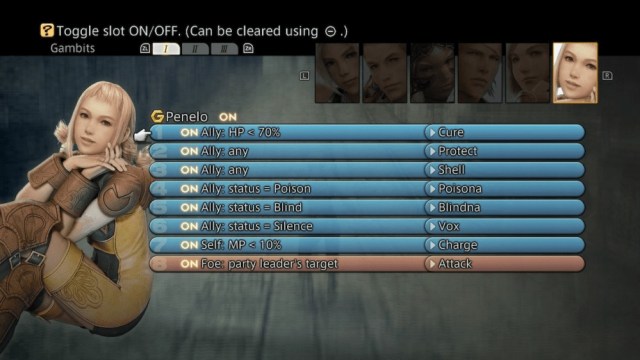
So, to make sure Penelo would prioritize healing my party above all else, I set the Gambit “Ally: HP < 70% -> Cure” at the top of her list. This means that curing anyone whose health was below 70% would be her absolute top priority. If everyone was above 70%, she’d then go down the Gambit list to cast Protect and Shell on the party to beef them up a little.
Going further down the list, I’ve got Gambits set up for her to heal the Poison, Blind, and Silence statuses in case anyone in the party got afflicted. If her MP ever dropped below 10%, she’d use Charge, which gives her a chance of regaining a bit of MP.
At the very bottom of the list, she has the Gambit “Foe: party leader’s target -> Attack” which allows her to use physical attacks on whichever enemy was being targeted by the party leader. If every single party member was healthy and weren’t afflicted by any status effects, then, and only then would she be allowed to start dealing damage.
On the flip side, I also needed to make sure I’d be able to make a bit of money while level grinding as well. And for that, I needed a Steal Gambit.
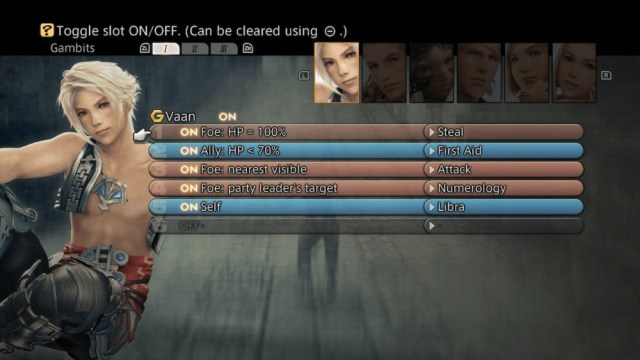
During the grinding process, I originally had Vaan’s Gambit set to “Foe: Any = Steal,” which led to a lot of frustration as I realized he would just keep stealing over and over even when there was nothing left to steal from any of the enemies.
Then I finally bought the magical “Foe: HP = 100%” Gambit, which would allow Vaan to only steal from enemies with full health. Once the enemy took even one point of damage (I’ve got a Gambit on another character for that, too), Vaan’s next priority (provided everyone was above 70%) would be to attack the nearest enemy.
At the bottom of his list, I’ve got “Self -> Libra” as well, which is a very low priority move that only procs outside of combat. Libra allows Vaan to identify traps in the dungeon so that my party can navigate it safely.
I used to have it at the top of my list when I was still experimenting with the Gambit system, only to realize that I absolutely did not need my party members casting Libra while a thousand enemies were whacking them at once.
Upon closer inspection, I’ve just realized that his Attack and Numerology Gambits aren’t exactly gelling well together, as Vaan would never use Numerology as long as he was prioritizing attacking the nearest visible enemy, so this Gambit list probably needs some adjustment. Hmm.
After realizing that I’d given Fran one of the worst possible jobs to start with in Final Fantasy XII (it was Time Battlemage, by the way), I quickly reset her License Board and started experimenting with some Black Mage spells instead. And wouldn’t you know it, this required a lot of Gambit fiddling as well.
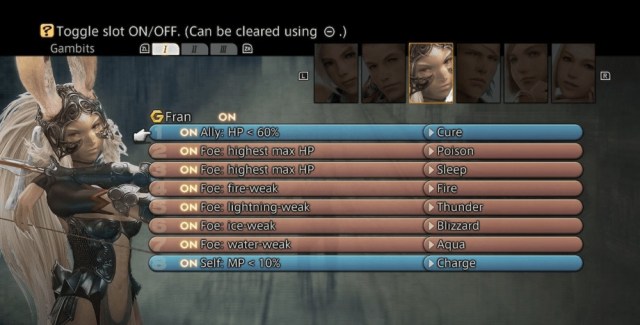
To start, Fran had access to Poison and Sleep, which were very useful spells, but not entirely necessary for grinding regular mobs. So as I leveled my party in the Lhusu Mines, I turned those Gambits off.
Instead of debuffing enemies, Fran would focus on casting spells. But I couldn’t just have her randomly casting spells on random enemies, hoping they stick. Final Fantasy XII has several spell-based Gambits as indicated above, such as “Foe: fire-weak” and “Foe: lightning-weak.”
Interestingly, there are also “Foe: fire-vulnerable” and “lightning-vulnerable” Gambits, which just allow you to target any enemy that’s susceptible to those elements.
However, in an attempt to be more efficient with Fran’s MP usage, I opted to go with the “weak” variants instead so that she would only cast those spells on enemies that were certain to take a crap ton of damage from them.
It’s not depicted in the above screenshot, but I later added a regular Attack Gambit at the bottom of her spell Gambits so that if she wasn’t able to exploit any spell weaknesses, she’d just use regular attacks instead.
After a couple hours of serious experimentation and trying to wrap my head around the Gambit system, I felt like I’d finally understood how the damn thing worked, and my party was ready to take on the Lhusu Mines on their own.
The next two to three hours passed in a flash, as all I had to do was use the left stick to walk my party into a group of enemies, and let them do their thing as I watched the cast of Lost find their way around the mysterious island on my TV screen.
After a few runs with three characters, I’d simply swap them out for my three reserve characters, make sure I had a dedicated healer, a dedicated thief, a strong party leader, and off they went.
It was pure magic. After the grind session, I’d gained a good few levels on everyone, and I even scored a rare Golden Armor drop from one of the skeletons.
Aside from just regular grinding, Final Fantasy XII gives you the opportunity to set up separate Gambit lists for boss battles as well, and the number of Gambit options you have in this game is absolutely staggering.
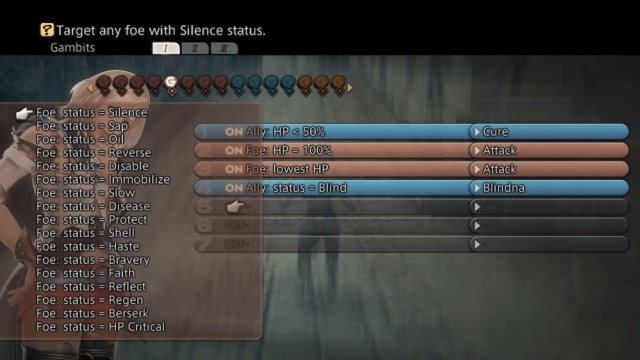
The list of Gambit options in the above screenshot alone don’t even begin to cover the number of options Final Fantasy XII throws at you. In the original PS2 release, the number of Gambits you could buy from shops were limited, and were only updated as you progressed through the story.
This was a nice way of getting players acquainted with the system slowly, by doling out a few options to you at a time.
With The Zodiac Age, the game makes every single Gambit available to you near the start of the game, and even introduces a few new ones for even further experimentation.
You’ve got Gambits to deal with all sorts of situations, from foes with specific statuses (positive or negative) to the number of foes in any given encounter, to item usage depending on how many of that item you’ve got left in your stock. It’s absolutely freaking insane, and I love it.
Final Fantasy XII’s Gambits are, quite possibly, the most in-depth combat mechanics I’ve ever seen in an RPG. This is a game that you can play by fiddling with its multitude of menu screens and options, creating new Gambit lists, experimenting with them, and tweaking them to perfection.
This is a game that rewards you for spending hours inside its menus, all so that you can set up Gambit lists for every single possible situation, whether it’s killing trash mobs, or taking down tougher foes.
It all fell into place when I reached the Tomb of Raithwall and was faced with a big bird boss battle. Sorry, FFXII fans, I don’t remember the bird’s name.
Anyhoo, I set up my Gambits, got my healer at the ready, and had Basch and Ashe take point as my damage dealers. Big Bird put up a good fight, and at one point, my party’s health even got dangerously low. But my characters were well-equipped for this exact situation, and everyone was healed up in no time. Big Bird went down quickly enough.
It was an exhilarating experience. I’d actually managed to clear a boss fight, albeit a fairly easy one, without any manual input. Setting the Gambits just right was like seeing the Matrix and loudly exclaiming, “Go forth, my children!” as my party indeed went forth and beat the boss without breaking a sweat.
Spend enough time within its overwhelming and intimidating menu screens, all to understand what every single Gambit does and how to prioritize them on your lists, and Final Fantasy XII will reward you with the god-like experience of watching your party wreck enemies while dealing with emergency healing, all without requiring any sort of input from you.
Of course, getting to that point requires tremendous investment on the player’s part, and I’m not even close to reaching that level of consistency just yet. But the goal is so tantalizing, and there’s something undeniably appealing and fascinating about being able to write scripts for each character, and programming them to do exactly what you want them to do in any given situation.
The strength of Final Fantasy XII’s combat doesn’t come solely from the Gambit system, of course. It’s also packed with this in-depth job system and dual-classing in The Zodiac Age that reminds me a lot of the excellent Octopath Traveler, but that’s a whole other discussion for another day.
Somewhat unexpectedly, Final Fantasy XII’s Gambits have turned me into the kind of player who fusses over every little detail in a game menu, and it’s kind of becoming an unhealthy obsession. And that, to me, is the mark of an RPG’s combat system done right.

